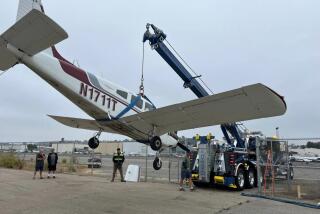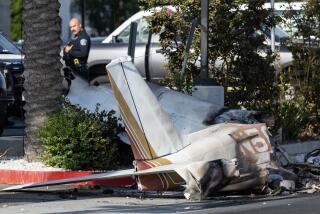Jetliner, Drug Agency Helicopter in Near-Miss Over L.A.
A United Airlines jetliner descending toward Los Angeles International Airport with 94 people aboard came within 200 feet of a U.S. Drug Enforcement Administration helicopter in what the United pilot described as a “near-miss,” officials said Thursday.
The Federal Aviation Administration, National Transportation Safety Board and DEA have launched their own investigations of the incident, which occurred at 11:10 a.m. Wednesday, about 5 1/2 miles east of the airport.
No one was injured in the incident. The Boeing 727-200 jetliner--United’s Flight 282 out of Monterey with 87 passengers and seven crew members aboard--made a normal landing and arrived at the airline’s terminal area seven minutes later. The pilot then filed a “near-miss” report with the FAA, according to United officials.
DEA Special Agent Dwight McKinney confirmed Thursday that the helicopter involved in Wednesday’s incident was being used by the agency. He declined further comment, saying that the DEA’s air wing in Addison, Tex., was investigating.
DEA officials there declined comment. Sources said that the helicopter, a Hughes 500D, was on loan to the agency from McDonnell Douglas Helicopter Co. in Mesa, Ariz.
A spokesman at United headquarters in Chicago said Thursday morning that the Boeing 727 was flying at about 2,100 feet and had been cleared to descend to 2,000 feet for landing on Los Angeles’ Runway 25 Left. The plane was banking to the right for its final approach when the captain spotted the helicopter from his left window, United spokesman Chuck Novak said.
The United pilot, whom Novak declined to identify, immediately went into a steep climb, flying over and above the helicopter at a distance the pilot estimated to be 200 feet, Novak said. However, on Thursday afternoon, Novak revised his earlier description of the incident, saying, “We are not at this time sure he took evasive action.”
The United spokesman said the jetliner was not turning at the time of the near-miss, but was “wings level” on its decent to the runway. The United captain saw the helicopter only after he had passed it and described it to controllers as merely an “aircraft,” not a helicopter, Novak said.
It was the FAA, apparently, that later determined that the aircraft was a helicopter, he said.
“We were under radar control,” Novak said of his company’s jetliner. “We were at the right spot.”
The FAA’s Park said that both the helicopter, which was flying north, and the jetliner were being tracked on radar, and that both pilots were in radio contact with ground controllers at the time.
Novak fixed the location of the near-miss as approximately above the Long Beach Freeway and Imperial Highway. However, James A. Wall, a National Transportation Safety Board investigator in Los Angeles, said that the incident occurred above the Harbor Freeway in the LAX Terminal Control Area (TCA).
Wall said late Thursday that he had not yet spoken with the United pilot, but had interviewed the helicopter pilot, who Wall said “had the jetliner in view the entire time and it didn’t appear that close to him.” Visibility at the time was three miles and hazy, Wall said.
FAA officials said the agency’s investigation had not yet determined whether either of the pilots or air traffic controllers were at fault in Wednesday’s near-miss.
According to FAA reports, there were 32 near-misses over Los Angeles County this year through Sept. 29. The average distance between planes in each instance was 310 feet.
Twenty of the reports were made by airline pilots; 16 of those involved near-misses with small planes.
Nine occurred near the Los Angeles airport.
Meanwhile, in a move they said was not related to Wednesday’s incident, FAA officials announced that they have essentially shelved a plan to use Los Angeles Police Department helicopters to help track pilots who violate the Terminal Control Area.
Park said the project has been put “way on the back burner” after agency administrators concluded that the police helicopters could not keep pace with most airplanes. The choppers fly at a maximum of about 120 miles per hour--a speed easily surpassed by all but the slowest fixed-wing aircraft.
Another reason officials dropped the idea of using police helicopters to chase errant pilots was because “a number of media wanted to get up there and be a part of the surveillance and we thought that that was not a good idea,” Park said.
FAA investigators initially planned on Oct. 18 to go aloft in two police helicopters as part of the agency’s promise to step up enforcement of the airport’s control area in the wake of the Cerritos collision Aug. 31 between an Aeromexico DC-9 jetliner and a small plane. The mission, however, was scrubbed before it could begin after what the agency termed “premature” exposure by the news media.
More to Read
Sign up for Essential California
The most important California stories and recommendations in your inbox every morning.
You may occasionally receive promotional content from the Los Angeles Times.









